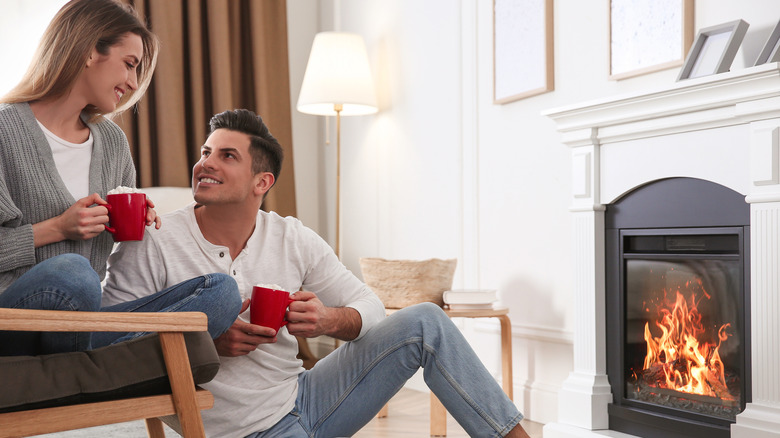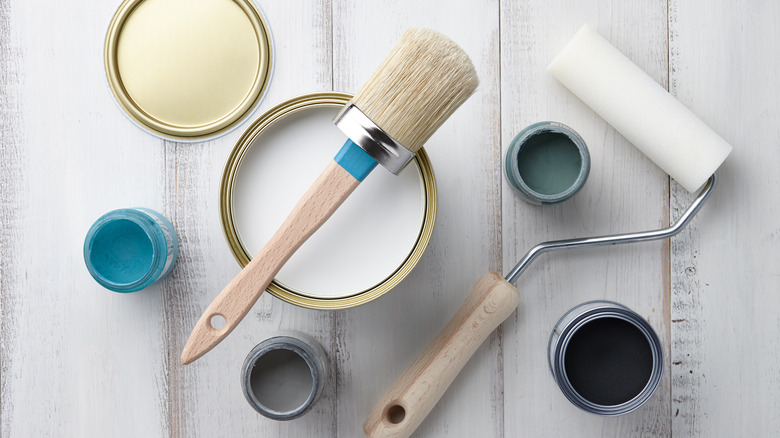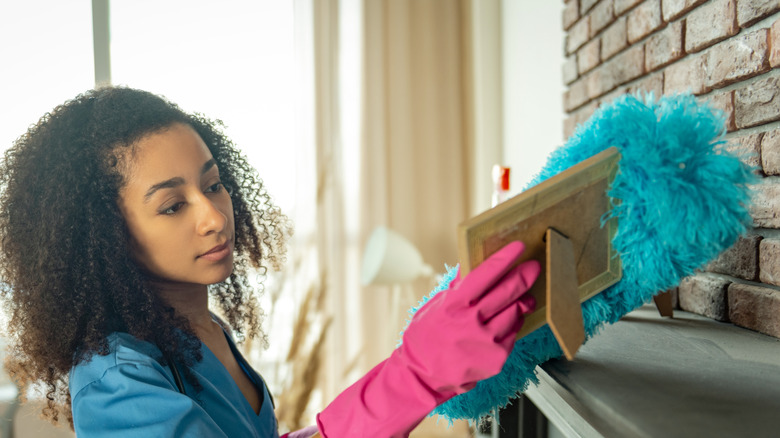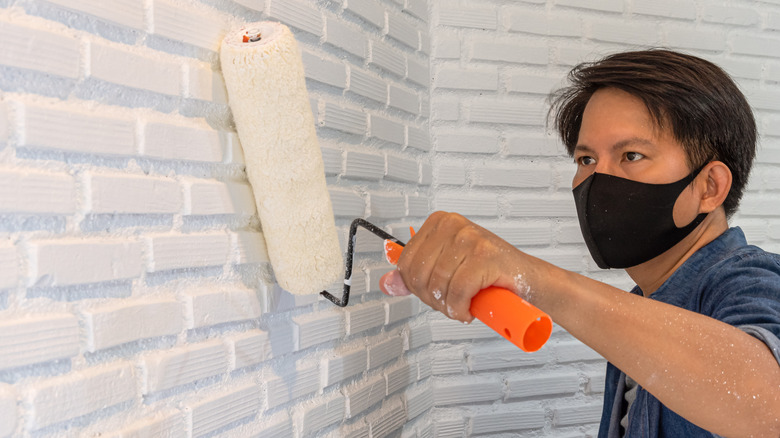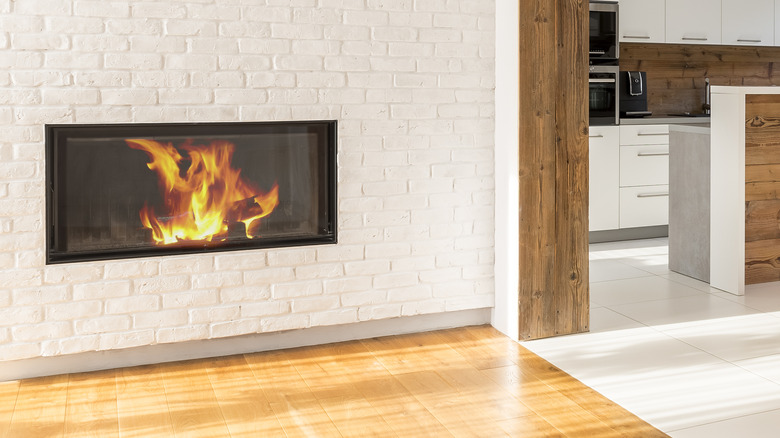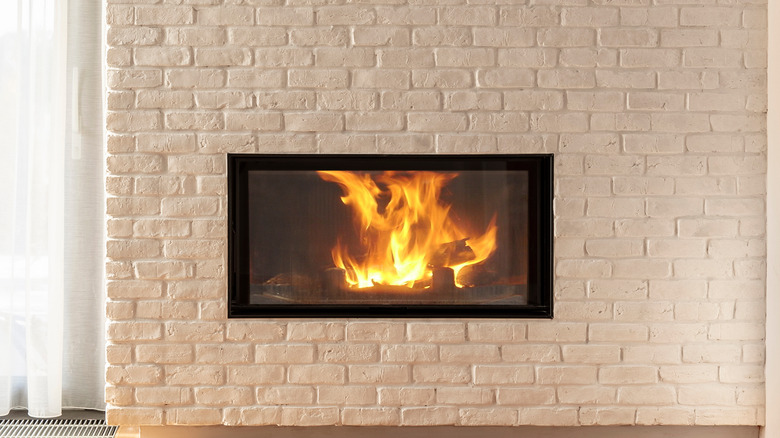How To Paint Your Brick Fireplace For A New Modern Look
A fireplace is the center of your living room. There's nothing better than gathering around the fireplace in the evenings. You can roast marshmallows, sip on hot chocolate, and converse on cool evenings. A fireplace is the perfect cozy detail to add to your home. They're particularly sought after by homeowners in colder climates, and, on average, homes with fireplaces sell for 13% more than the national median, according to Angi. Many older homes have brick fireplaces that homeowners consider a little outdated. So how can you give your fireplace a new modern look?
One of the easiest ways is to give your fireplace a fresh coat of paint. This is a project that many homeowners can DIY with a few supplies bought at the local hardware store. Not only is paint a budget-friendly renovation option, but it's also highly customizable. You'll be able to match your home's color scheme and interior style with ease. Whether you're looking for a modern farmhouse or a bold glamorous style, painting a fireplace can achieve that.
Gather supplies
Before starting your project, you want to ensure that you have all the right supplies. Of course, the most important thing you'll need is the paint. There is masonry paint that's made specifically for bricks and you can use that. However, with a brick fireplace, interior latex paint can be just as effective, says Craftivity Designs. With interior paint, you also want to think about the finish. Flat and matte finishes add a modern touch but can be difficult to clean, according to The Savvy Heart. Eggshell is easier to clean and has a velvety appearance. The easiest finishes to clean are satin, semi-gloss, and high gloss finishes, so they might be best for your fireplace.
You'll also want a tinted primer to give the bricks a base coat before painting. Have on hand paintbrushes in a few sizes, especially to get into smaller spaces or crevices. A high nap roller that is designed for rough surfaces will help you go over the bricks with ease and cover the tiny valleys inside the bricks.
Clean the bricks
Before painting, you'll want to clean the brick to give yourself the best canvas to work with. This is especially important if you haven't cleaned the bricks in a while as dust can gather and provide an uneven surface for painting. Soot from a fire is especially important to remove before doing any painting. According to Home Depot, to properly clean your fireplace bricks, you'll want to remove dust and dirt, use a store-bought cleaner, and rinse with water. A masonry sponge will be a helpful tool, but a soft-bristled nylon brush will also work well. Avoid using wire brushes as they can damage the brick and potentially leave behind metal bristles that may rust.
Start by cleaning the surface of dirt and dust with a vacuum. This will avoid dirt and dust getting sludgy with a liquid cleaner or water. Next, you'll want to use a cleaner, but don't apply it directly to the surface since brick is porous and excess moisture can discolor or ruin the brick. Instead, mist the bricks with water before applying the cleaner. Rinse with warm water and a masonry sponge. Allow the bricks to dry completely before painting.
Prime the bricks
Once the brick has dried, you'll want to prime it. Priming the bricks before painting ensures that you get even color across your entire fireplace. Priming before painting also helps the paint stick to the surface better, so you'll be less likely to have to repaint because of peeling paint. Sarah Joy suggests choosing a primer, sealer, and stain blocker all in one to give you the best outcome. Also, choosing a primer that's made for porous surfaces like brick will also provide sealing to keep the paint looking its best.
You might also want to look for a primer that's pigmented. A pigmented primer will provide an even base coat over colorful bricks like bright yellow or deep red, as well as dark mortar lines. Use the high nap roller to paint the primer over the entire fireplace. Small paint brushes will allow you to get into the corners, edges, and along the wall and floor lines. A good primer should only require one coat.
Paint with your desired color
Once the primer is completely dry, you can begin painting your fireplace. Again, you'll want to use a high nap roller to cover most of the fireplace and brushes to get into the small crevices. It's also a good idea to tape around your fireplace to avoid getting any paints on your walls or floors.
When choosing a paint color, you'll want to determine if the fireplace is a focal point of the room or if it blends in with the rest of the decor, says Fireplace Painting. Neutral colors like a crisp white or a bold black look great in nearly every space no matter what the interior style is. But you can also create contrast by painting the fireplace bricks one color and the mantel in a contrasting shade. Or if you want the fireplace to blend in, you can paint the walls and the fireplace similar shades. Don't be afraid to go bold with the fireplace with shades of blue and green, or even yellow and pink.
Choose the right paint for the firebox
But wait, don't paint the entire fireplace just yet. The bricks on the exterior of the fireplace are fine to paint with exterior paint. Just wait a few days for the paint to dry and for fumes to disperse before using your fireplace again. But you shouldn't use the same paint to paint the firebox of the fireplace. As the name implies, the firebox is the open space where the flames are in both wood and gas-burning fireplaces.
Using a standard interior paint inside the firebox could lead to the paint blistering, cracking, or peeling, says Schaus-Vorhies Companies. Instead, you'll want to use a heat-resistant paint. Heat-resistant paint can stay intact up to 18,000 degrees Fahrenheit. They can be silicone or epoxy-based, ceramic, powder, sprayed metal, or metal additive. You don't have to paint the firebox in your fireplace, but if you do choose to give it a coat and light a fire, be sure to buy heat-resistant paint for the job.
